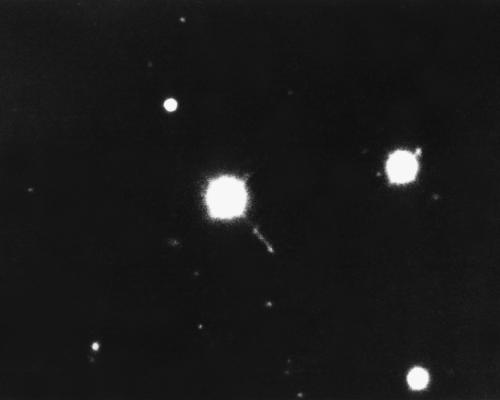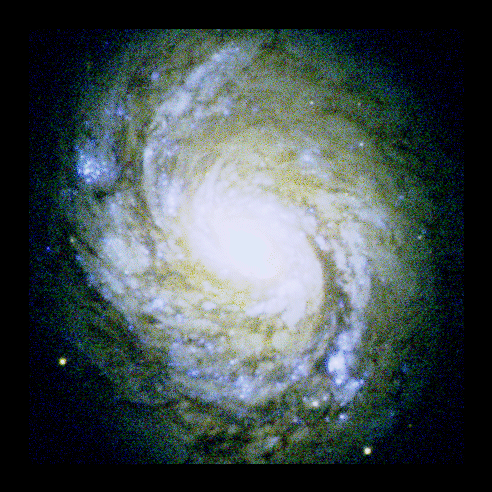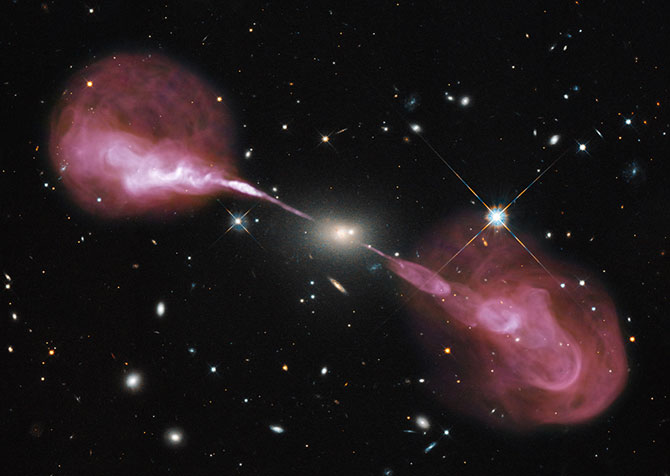

|
3C273 optical image and spectrum
 |
 (courtesy Bill Keel, UAlabama)
|
In 1963, Maarten Schmidt realized that the emission lines from the quasar 3C 273 were actually from a very well-known element: hydrogen. They were, however, shifted to much redder wavelengths than expected, indicating (by Hubble's law) that the object was very far away.
An aside: redshifts
At large recession velocities, astronomers typically talk about the redshift of a galaxy, given by measuring the wavelengths of their spectral lines. Redshift ("z") then measures how far those lines are shifted from their normal wavelength.
Small z: low velocity -- nearby object. Large z: high velocity -- distant object.
Most galaxies we see pretty pictures of are nearby with small redshifts of z<0.05.
Shortly thereafter, another quasar, 3C 48 was found to have a redshift z=0.367, putting it ~1500 Mpc away.
(note: at
these redshifts, the notion of distance becomes ill-defined, because of
the curvature of space. we'll talk about that more when we talk about
cosmology!)
Quasars were the most distant objects ever discovered. Yet they are relatively bright. This means the must be extremely luminous: 103 - 105 times more luminous than the entire Milky Way.
The first hint of strange activity
in otherwise normal galaxies came from the spectrum of NGC 1068. NGC 1068 was found to have
broad and narrow emission lines
in its nucleus, produced by highly ionized gas.
NGC 1068 is an example of a Seyfert galaxy. We classify Seyfert galaxies by their emission line shapes.
|

|
Spectrum of a Seyfert 1 galaxy:

Seyfert galaxies are typically spiral galaxies, and often
have nearby companions. While the spectrum of the galaxy shows stellar light,
the spectrum of the nucleus shows a complicated spectrum, dominated by synchrotron
radiation.
As radio astronomers mapped the sky, they found several bright
radio sources associated with distant galaxies. One of the brightest was
the radio source Hercules A.

Hercules A: radio emission (pink) overlaid on optical.
Hercules A is a double-lobed radio source, where the lobes contain hot, ionized gas. Also notice the jets from the center. At the center sits a giant elliptical galaxy, at a distance of ~ 650 Mpc (z=0.155). At this distance, the lobes are separated by more than 250 kpc, and they have a radio luminosity of ~ 1045 erg/s, 106 times greater than the radio luminosity of normal galaxies.
Radio galaxies, unlike Seyferts, are generally hosted by elliptical galaxies, not spirals. Seyferts are also radio quiet.
M87, the central elliptical
in Virgo, also is a radio galaxy. It is close enough that we can examine its
center in detail,
where we can actually see the jet in the optical:

How are quasars, Seyferts (1 and 2), and radio galaxies
related? What about blazars, BL Lac objects, OVVs
, etc? A complicated taxonomy -- what's going on?